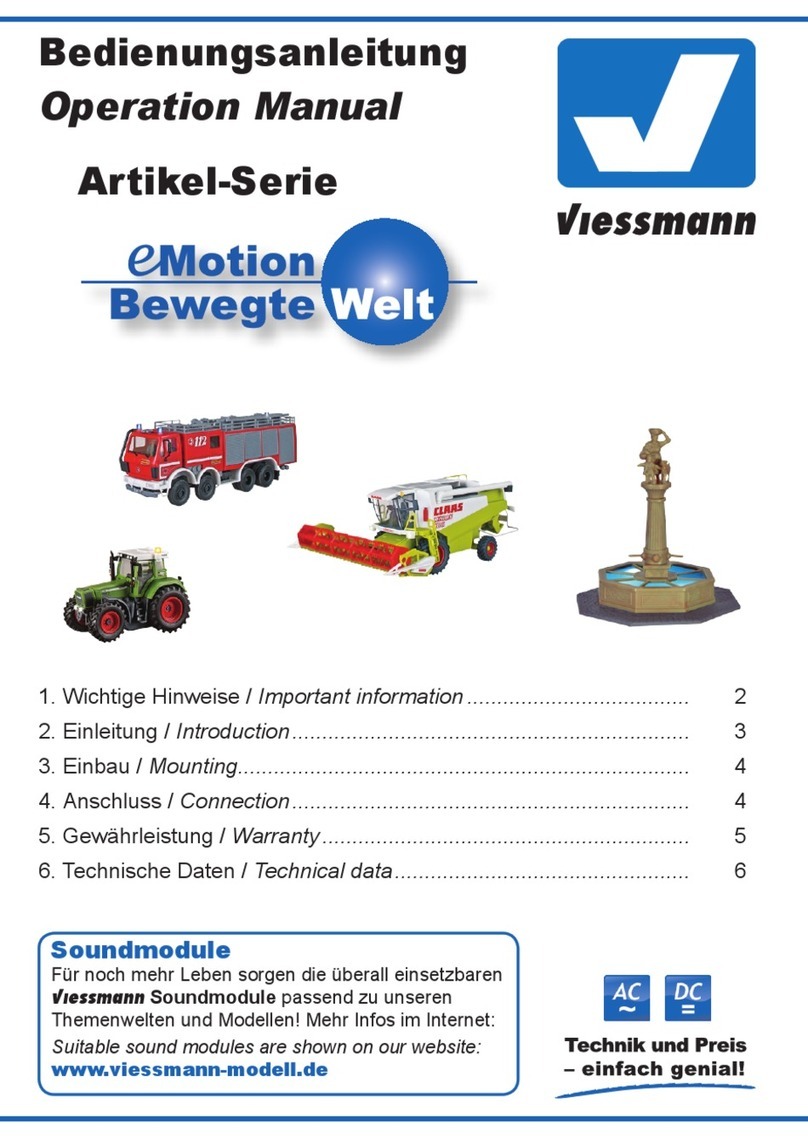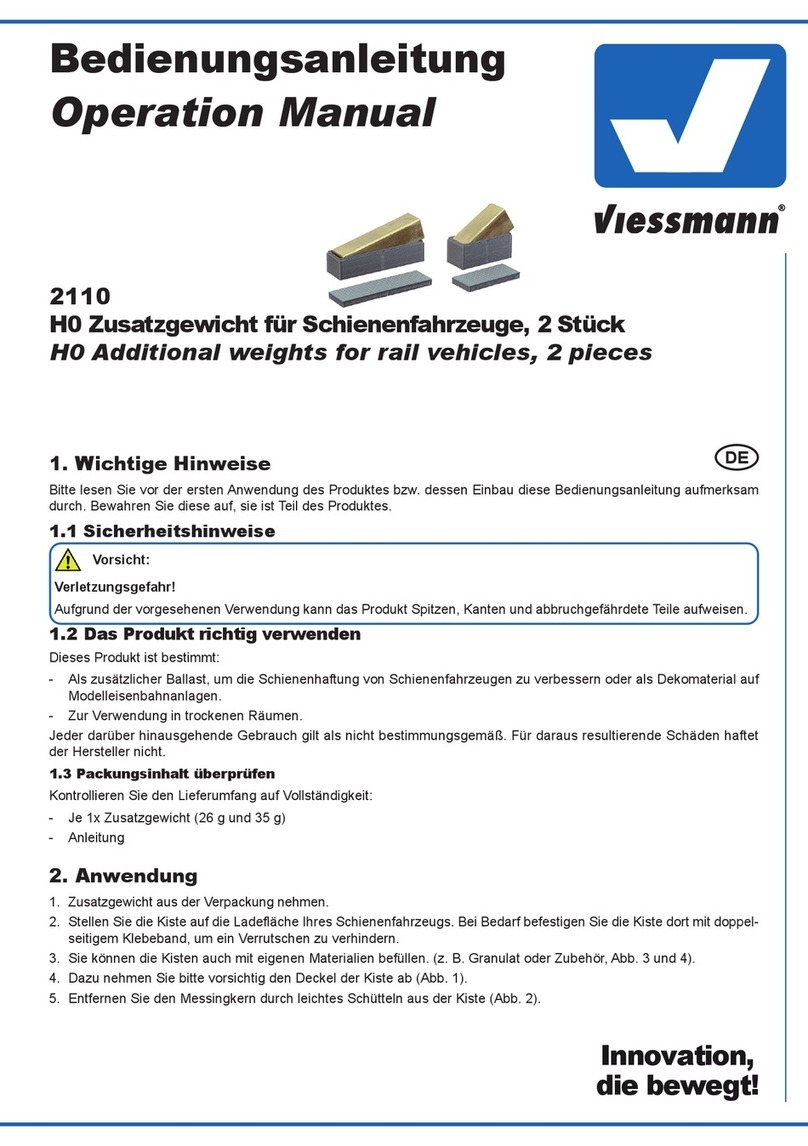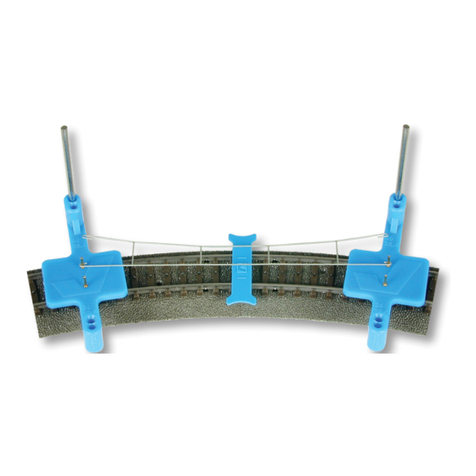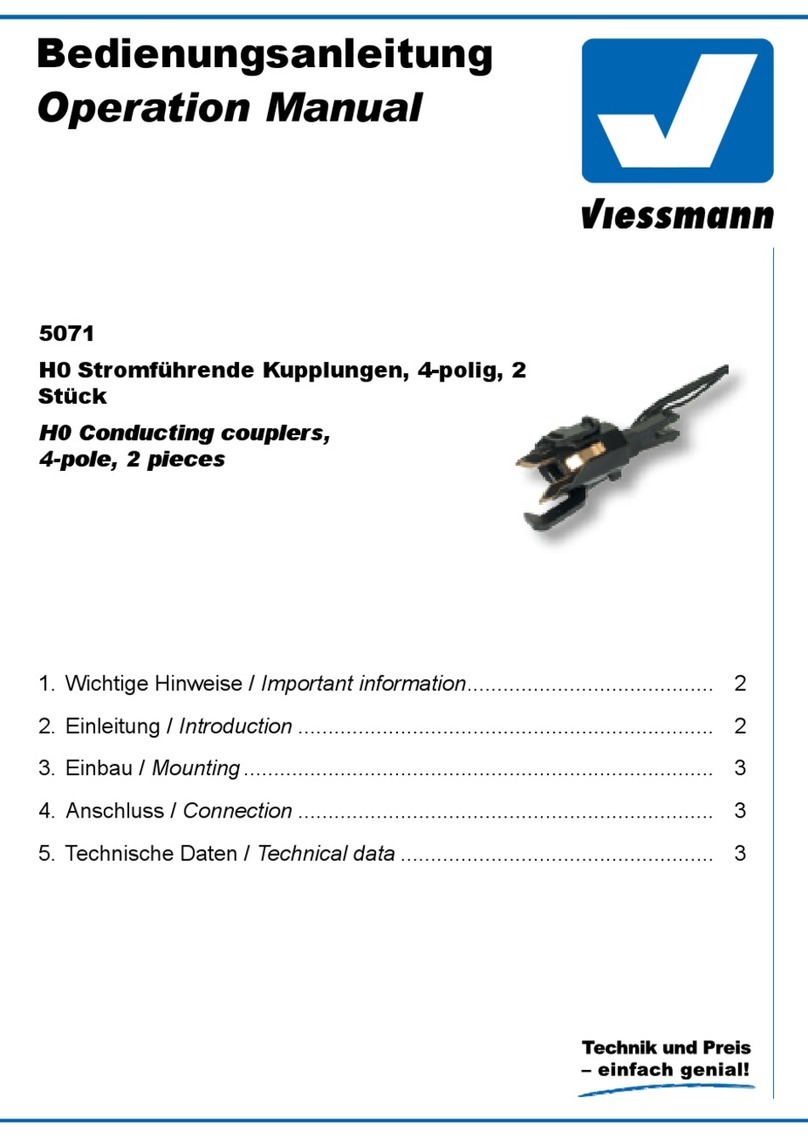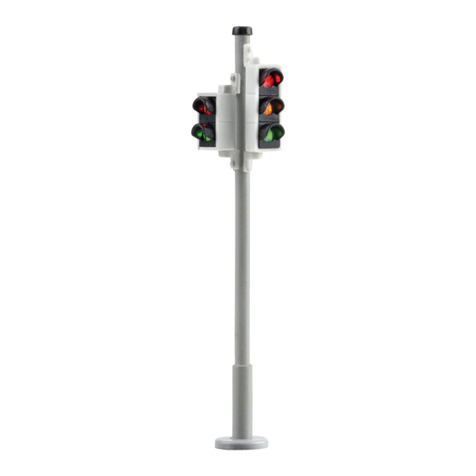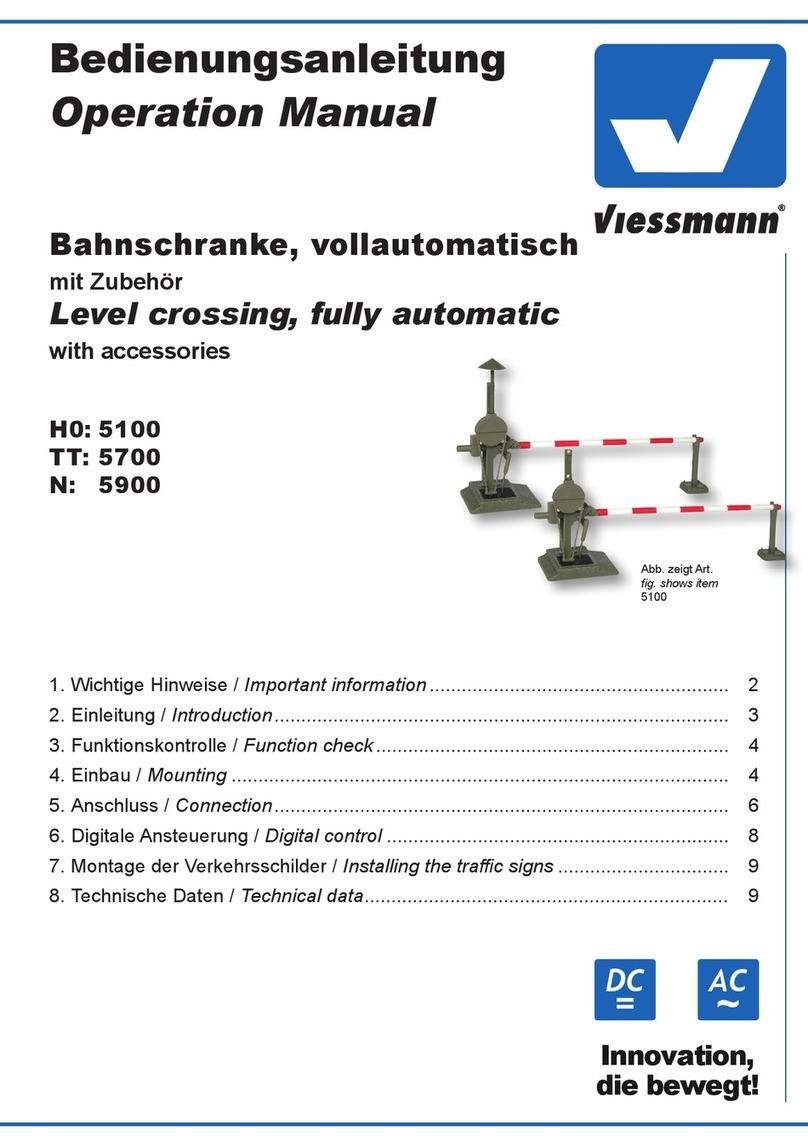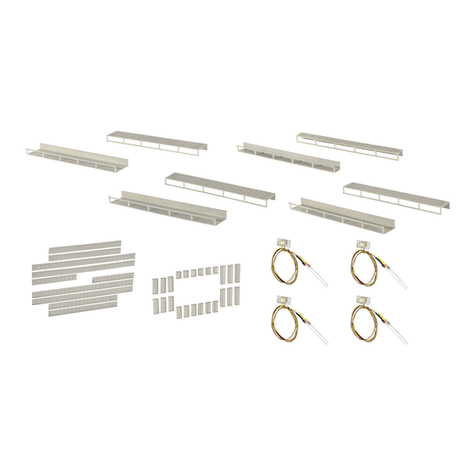
10
Name der CV
Name of CV
CV-
Nr.
No.
Eingabewerte
(Default)
value range
Erläuterungen / Hinweise Remarks
Basisadresse
Primary address
1 1 … 255 (3) Wertebereich bei DCC: 1 … 127 Range of values in DCC: 1 ... 127
Hinweis: Wenn für die Basisadresse ein Wert > 127 programmiert wird und die Verwendung der erweiterten Adresse in CV 29 ausgeschaltet
ist, reagiert der Decoder nicht auf DCC-Befehle.
Hint: If a value higher than 127 is set for the basic address and the use of extended addresses in CV 29 is set to off, the decoder does not
react to signals in DCC format!
Startspannung
Starting voltage
2 0 … 63 (2) Minimale Spannung, die an den Motor
ausgegeben wird. Wert 1 ist ca. 1/1000 der
Maximalspannung, um eine sehr langsame
Fahrt bei Fahrstufe 1 erlauben zu können.
The minimal voltage for the motor. A
value of 1 means approximately 1/1000
of the maximal voltage, to allow a slow
speed at speed step 1.
Beschleunigungsrate
Acceleration rate
3 0 … 63 (10) Wartezeit, die beim Beschleunigen der Lok
jeweils vor dem Hochschalten zur nächst
höheren Fahrstufe vergeht. Berechnung: Zeit
zw. min. und max. Fahrstufe = Wert von ca.
CV 3 x 0,9 sec.
Delay before the switching to the next
higher speed level when the loco is
accelerating. Calculation: time between
min. and max. speed steps = value of
appr. CV 3 x 0.9 sec.
Bremsrate
Deceleration rate
4 0 … 63 (8) Wartezeit, die beim Abbremsen der Lok
jeweils vor dem Herunterschalten zur nächst
niedrigeren Fahrstufe vergeht. Berechnung
wie unter CV 3.
Delay before the switching to the next
lower speed level when the locomotive
is braking. The delay is calculated as
described in CV 3.
Höchstgeschwindigkeit
max speed
5 0 … 255 (255) Maß für die maximale Spannung, die an den
Motor abgegeben wird.
Quantity of the maximum voltage which
is delivered to the motor.
Versionsnummer
Version number
7 (1) Nur lesbar /
Motorola: erweiterte Programmierung.
Schreiben von Wert 7 ermöglicht erweiterte
Programmierung unter Motorola.
Read only! /
Motorola (extended programming): Writ-
ing of value 7 allows extended program-
ming in motorola protocol.
Hersteller
Manufacturer
8 (109) Nur lesbar /
Reset auf Werkseinstellungen: Schreiben
von Wert 8 setzt alle Werte auf Auslief-
erungszustand zurück. Schreiben von Wert
9 setzt alle Werte außer Lokadresse, CV
29 und Fahrstufentabelle auf Auslieferungs-
zustand zurück.
Read only! /
Factory Reset Writing a value of 8
resets all CVs to the factory default
settings. Writing 9 resets all CVs except
the address, CV 29 and the speed step
table.
Zwangsbremsung
Packet time-out
11 0 … 255 (100) Autom. Halt bei Signalausfall von der Digi-
talzentrale. Berechnung: Wert x 0,1 = Zeit
[sec] bis Stop-Auslösung. Wert 0 deaktiviert
dieses Feature.
Contains the maximum time period (in
0.1 sec.) that the decoder will maintain
its speed without receiving a valid
packet addressed to it.
Erweiterte Adresse
Extended address
17 192 … 255 (192) Erlaubt Adresse über 127 wenn die lange
Adresse im CV 29 aktiviert ist, nur für DCC.
Bei den meisten Zentralen ist es möglich,
erweiterte Adressen direkt einzugeben. Die
CVs 17, 18 und 29 werden dann von der
Zentrale automatisch richtig eingestellt.
Allows addresses above 127 if the long
address is activated in CV 29, in DCC.
Most command stations permit entering
long addresses directly. In this case the
CVs 17, 18 and 29 are set automatically
to the proper values.
18 0 … 255 (0)
Mehrfachtraktions-
adresse
consist address
19 1 … 127 (0) Adresse für die Lokomotive im Mehrfachtrak-
tionsmodus.
Address for locomotives in multi-traction
mode.
Funktionen im Mehr-
fachtraktions-Modus
consist mode
function status
21 0 … 255 (0) Bit auf Wert “0” bedeutet, dass die entspre-
chende Funktion nur über die Lokadresse
gesteuert werden kann. Bit auf Wert 1 er-
laubt, die Funktionen über die Mehrfachtrak-
tions-Adresse zu schalten.
F1 ein = 1; F2 ein = 2; F3 ein = 4;
F4 ein = 8 … F8 ein = 128
Bit with a value of “0” indicates that the
function can only be controlled by the
locomotive address. A value of “1” al-
lows the function to be controlled by the
consist address.
F1 on = 1; F2 on = 2; F3 on = 4;
F4 on = 8; ... F8 on = 128
Bremsverhalten bei
Gleichspannung
Decoder automatic stop-
ping conguration
27 0, 16, 32, 48 (16) Kein Bremsen bei Gleichspg. = 0
Bremsen bei Gleichspg. in Gegenricht. = 16
Bremsen bei Gleichspg. in Fahrtricht. = 32
No braking with D.C. = 0
Braking with D.C. in reverse dir. = 16
Braking with D.C. in actual dir. = 32
Hinweis: Standardmäßig wird bei Anliegen einer Gleichspg. am Gleis in den Analogbetrieb umgeschaltet. Setzen Sie den Decoder auf einer
Anlage mit einer Bremsstrecke ein, die auf dem Anlegen einer Gleichspg. basiert (z. B. Märklin-Bremsstrecke), muss das Umschalten auf
Analogbetrieb verhindert und sichergestellt werden, dass die Lok wie gewünscht auf die Bremsstrecke reagiert. Wird für den Decoder ein
Bremsen bei positiver oder negativer Gleichspg. eingestellt, wird automatisch die Analogerkennung ausgeschaltet.
Hint: It is standard to switch over into analogue mode when applying a DC voltage at the rails. In case that the decoder is run in a layout with
a braking route based on applying a d.c. voltage (e. g. Märklin-braking route), the locomotive has to be prevented from changing over into
analogue mode and it has to be ensured that the locomotive reacts as expected on the braking route. When braking with positive or negative
d.c. voltage is set for the decoder, the analogue recognition is switched off automatically.
RailCom
RailCom
28 0 … 3 (3) Bidirektionale Kommunikation:
inaktiv = 0,
Adresse senden = 1,
Quittung und POM aktiv = 2
Bi-Directional Communication:
disabled = 0,
Address broadcast enabled = 1,
Acknowledge and PoM enabled = 2
